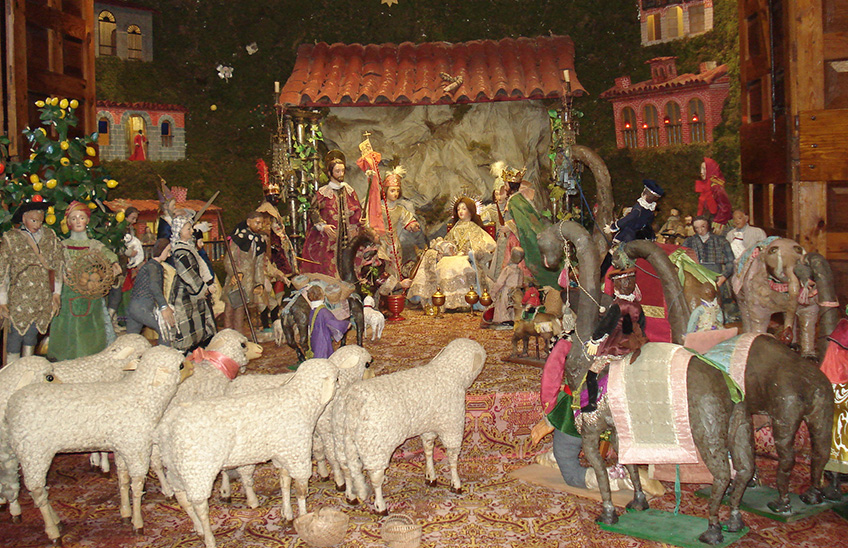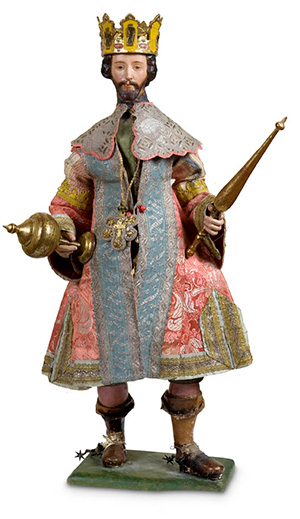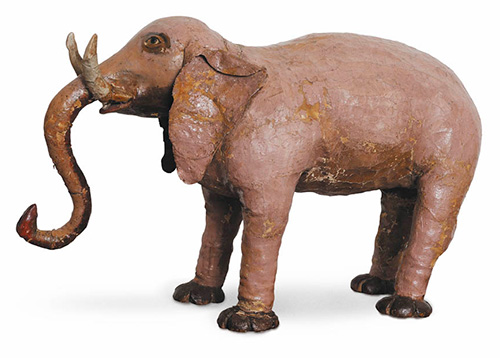The Dean of the Nativity Scenes of Navarre in the Augustinian Recollect Nuns of Pamplona

Undoubtedly, the group of the Augustinian Recollect Nuns of Pamplona is the most outstanding group nativity scene preserved in Navarre from the centuries of the Baroque. Its chronology, notoriety and size make it comparable to other monumental nativity scenes preserved in other Hispanic female cloisters.
Thanks to a manuscript preserved in his file, dated in 1886, we know all subject of details related to its arrangement and placement in the conventual anteroom, inside a gigantic closet, in the manner of the Mallorcans. On Christmas Eve, before the conclusion of the Midnight Mass, one of the beleneras would place the Child, wrapped in a sash on portal, before the Virgin kneeling next to the Incarnate Word. The nuns would then sing some traditional carols of the house, of which we know copies in handwritten scores.
On the day of the Circumcision, the passage was staged with the High Priest and his acolyte, before the Virgin who was touched with a mantle. Finally, on the day of the Epiphany, the Virgin, seated in a rich golden armchair and richly dressed, with the Child on her knees, received the kings of the earth, in a position of authentic Maiestas Mariae. Christ made man, on the day of his public manifestation, was to receive the monarchs of the earth as King of heaven, on the best of thrones: his Mother. The symbolism is present, in a very special way, as it corresponds to the traditional Hispanic nativity scene.
The different figures that make up the set belong to different dates, from the time of Philip IV, in plenary session of the Executive Council foundational and endowment process of the convent, to the eighteenth century, when fashions were going faster, because of royal tastes, in the time of Charles III. The Nativity, the Kings and some shepherds were exhibited in Madrid in the year 2000, when the most urgent restoration was carried out. In Pamplona it could be contemplated in the exhibition A Belén pastores! ( 2006-2007).

Magician King of the Nativity Scene of the Augustinian Recollect Nuns of Pamplona, XVIIth century
The nuns were in the second half of the XVIII century very conscious of the importance and novelty of the set of dressed figures that they had in their nativity scene. This is evidenced by the fact that they decided to take it to the streets for exhibition, at a very singular moment in the history of Pamplona, when the communities, guilds and nobles of the city decorated their facades and streets with their best decorations, in a context of great skill among all of them to attract the attention of those who had come to the Navarrese capital for the inauguration of the chapel of the Virgen del Camino, in 1776. A handwritten chronicle of the procession on that occasion states: "in the corner of the tower of San Lorenzo towards the Taconera, the Recollect Mothers placed a very high altar. The objects of that altar were Our Lady of the Conception and Saint Augustine. The riches of that altar had no rate, they were in symmetry and had so much to amuse, that the curious did not stop as long as they could manage. On the ceiling, which was a kind of solio, they placed the nativity scene, which they have very special, with very strange and perfect animals, which caused admiration...". So much for the eighteenth-century manuscript, whose testimony about the singular appreciation of the nativity scene by its owners and by the people leaves no room for doubt, at a time when the nativity scene had not yet made its presence felt in the streets.
The Recoletas Nativity Scene of Pamplona consists of an important issue of pieces, all of them candlestick sculptures, numerous animals and architectural constructions that reproduce the arched galleries of the Recoletas place itself, specifically of the house of the chaplains of the convent, a work of the XVII century. The elaborate costumes of the images, especially those of the Magi, give the set a grandeur and textures of enormous richness, as in other similar sets of the time. Among the oldest pieces are the figures of the mystery, St. Joseph with certain Romanesque traces on his face and the Virgin, with finer features and polished incarnation, seated in a richly upholstered and gilded armchair. They also belong to the time of Philip IV a group of beggars, dressed in the fashion of the second third of the seventeenth century, showing their mutilated legs and sores on their flesh. Not far behind in chronology is a group of women, widows, seated one after the other, forming a curious row. Widows and the poor came to signify that Christ's coming into the world was universal, also for the most disadvantaged.
Special importance is given to the figures of the archangels St. Michael and St. Raphael in the portal , following the texts of Sister María Jesús de Ágreda, who glosses in her Mystical City of God, the presence of both of them in the birth of Christ.
Along with outstanding pieces, we find some of a markedly popular character, such as a group of villagers, whose faces are inspired by types from the Pamplona basin. Very curious is a shepherd dressed as a pilgrim, with all the typical iconographic attributes, such as the gourd, the staff, the canteen, the scullion and the shells.

Elephant from the nativity scene of the Augustinian Recollect Sisters of Pamplona, XVIII century.
We cannot fail to mention elephants and camels, the latter being diachronically surreal. These exotic animals were added to the processions of the Magi, as a result of the pilgrimages to the Holy Land. Regarding the elephant, let us remember that its incorporation to the nativity scene was relatively recent and was motivated and increased by the arrival of a specimen in the embassy of the Ottoman Sultan Mahmut I to Carlos de Borbón Farnesio, king of Naples and two Sicilies, future Carlos III, in that same year of 1741, as we see in the painting of Giuseppe Bonito of the mentioned year. That embassy of 1741 was a social and political event in Naples, both for the issue of visitors and for the unique and exuberant costumes, as well as for the exotic animals that accompanied them. It was not the only elephant that Charles III received as a gift. In 1773, another one arrived from Manila, which traveled through many regions until it arrived at the court, with all the care subject . The monarch's fondness for the nativity scene since he reigned in Naples, made that in Spain it acquired in his time authentic cover letter. The different novelties, among them the presence of the elephant, made that a reduction of the pachyderm became a three-dimensional representation of the birth of Christ and that other nativity scenes included it in their showy cavalcades because of its exoticism.
Particular history possesses a good group of sheep, of great size that were incorporated early to the nativity scene, although they were not made for the set. At least, in 1717 they already existed, since they were placed at the foot of a pyramidal altar that the nuns prepared, near their convent, in the same tower of the parish of San Lorenzo, for the celebrations of the inauguration of the chapel of San Fermín. The chronicle calls them "tender lambs".
LEARN MORE
FERNÁNDEZ GRACIA, R., Historical Nativity Scenes in Navarra. Figures for the report, Pamplona, Chair de Patrimonio y Arte Navarro, 2005.
FERNÁNDEZ GRACIA, R., To Bethlehem shepherds! Historical Nativity Scenes in Navarre, Pamplona, Government of Navarre-Pamplona City Council, 2007.
FERNÁNDEZ GRACIA, R., Tras las celosías. Patrimonio material e inmaterial en las clausuras de Navarra, Pamplona, University of Navarra - Fuentes Dutor Foundation, 2018, pp. 153-147.
